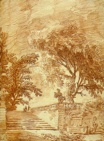 chalk - Pigments mixed with gum
and pressed into a stick form for
use as crayons. Pastel
is similar, but less tightly bound.
chalk - Pigments mixed with gum
and pressed into a stick form for
use as crayons. Pastel
is similar, but less tightly bound.
Examples of works in chalk:
Rosso Fiorentino (Giovanni Battista di Jacopo di Guasparre) (Italy, Florence, 1494-1540), Judith with the Head of Holofernes, c 1538-40, red chalk, 9 1/8 x 7 3/4 inches (23.2 x 19.7 cm), Los Angeles County Museum of Art.
Peter Paul Rubens, Portrait of the Daughter of Balthasar Gerbier d'Ouvilly, 1629, black, red and white chalk, with touches of pen with brown ink, on yellowish-grey paper, 33.5 x 23 cm, Hermitage Museum, St. Petersburg, Russia.

Rembrandt van Rijn (Dutch, 1606-1669), The Last Supper, after Leonardo da Vinci
(Italian, 16341635), red chalk, 14 1/4 x 18 3/4 inches (36.2
x 47.5 cm), Metropolitan Museum of Art, NY. See after
and Baroque.
![]()
Rembrandt van Rijn, Nude Woman with a Snake, about 1637,
red chalk heightened with
white body color, 9 11/16
x 5 7/16 inches (24.7 x 13.7 cm), J. Paul Getty Museum, Malibu,
CA. See snake.

Antoine Watteau, Head of a Man, c. 1718, red and black
chalk, 5 7/8 x 5 3/16 inches (14.9 x 13.1 cm), Metropolitan Museum
of Art, NY. See Baroque
and Rococo.

Jean-Honoré Fragonard (French, 1732-1806),
A Gathering at Woods' Edge, c. 1760-1780,
red chalk, 14 3/4 x 19 3/8 inches (37.5 x 49.2 cm), Metropolitan
Museum of Art, NY.

Hubert Robert (France, 1733-1808), Landscape with Steps, 1770s, red chalk, 17 1/2 x 12 5/8 inches (44.5 x 32.1 cm), Los Angeles County Museum of Art.

Hilaire-Germain-Edgar Degas (French, 1834-1917),
Édouard Manet, Seated, 1866-68,
portrait of Édouard Manet (French, 1832-1883), black chalk on off-white wove paper; sheet: 13 1/16
x 9 1/16 inches (33.1 x 23 cm), Metropolitan Museum of Art, NY.
See Impressionism.

Claude Monet (French, 1840-1926), Maisons près de la mer, 1865, black chalk on paper, 9 3/4 x 13 1/4 inches (24.6 x 33.4 cm), Museum of Modern Art, NY. See Impressionism.

André Breton (French, 1896-1966), Valentine Hugo (French, 1890-1968), Greta Knutson and Tristan Tzara (French, born Romania. 1896-1963), Landscape, c. 1933, an exquisite corpse or cadavre exquis, colored chalk on black paper, 9 1/2 x 12 1/2 inches (24.1 x 31.7 cm), Museum of Modern Art, NY.
Joseph Beuys (German, 1921-1986), Schultafel, 1974, chalk on painted board, 37 1/4 x 48 3/4 inches (94.2 x 123.8 cm), Museum of Modern Art, NY. See German art.
|
Hey!
What you need:
Process: 1. Simply combine 1-part non-toxic plaster of Paris and 1-part tempera paint into a bowl and stir until the consistency is that of frosting. You may need to add either more plaster or tempera to reach this consistency.
Variations: 1. If it's easier, you can substitute powder pigments and water for tempera paint. 2. Layer colors in cups for a striped chalk, or swirl them for a marbled effect. 3. Add your favorite color of glitter for a shimmering result. 4. Spread tempera /plaster of Paris mixture into plastic cookie cutters for sidewalk chalk in fun shapes — maybe even silhouettes! 5. With a handful of ceramic or modeling clay, produce a small pinch pot into which to cast your sidewalk chalk. 6. Because small pieces of chalk and pastel can be difficult to hold, some of us throw them away. Don't waste them! Add these little nuggets to your mixture of tempera and plaster for a fun aggregate of extra colors. |
Also see conté crayon.
https://inform.quest/_art
Copyright © 1996-![]()